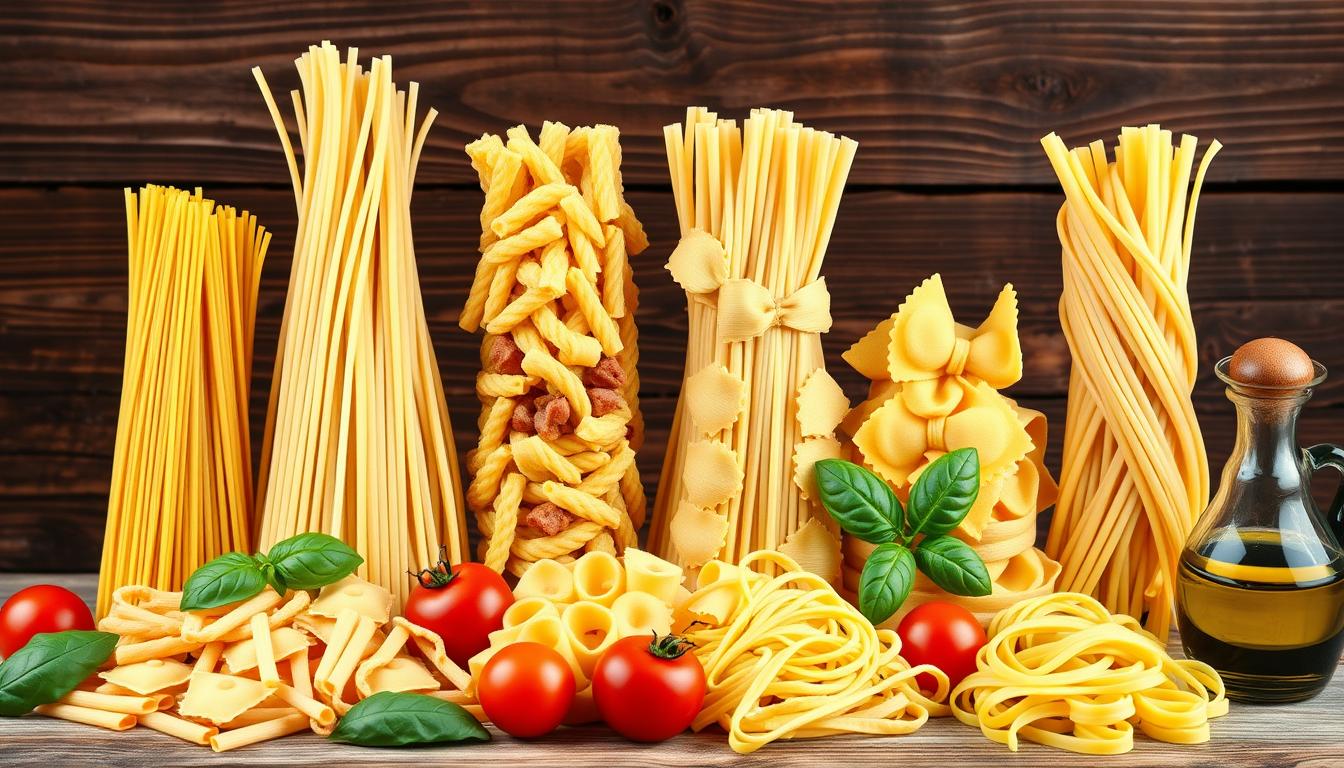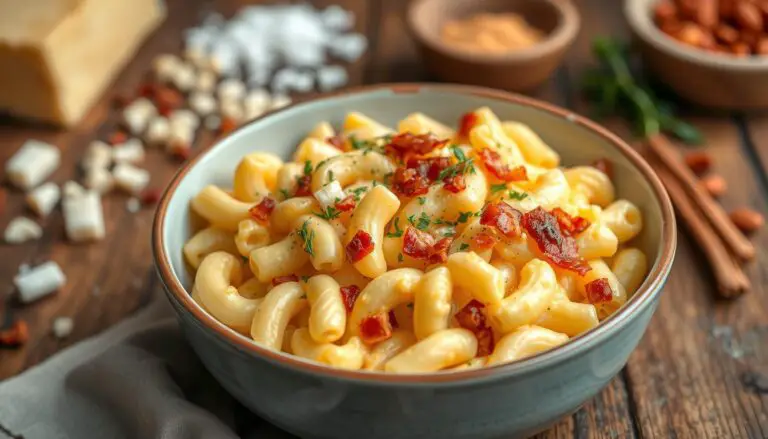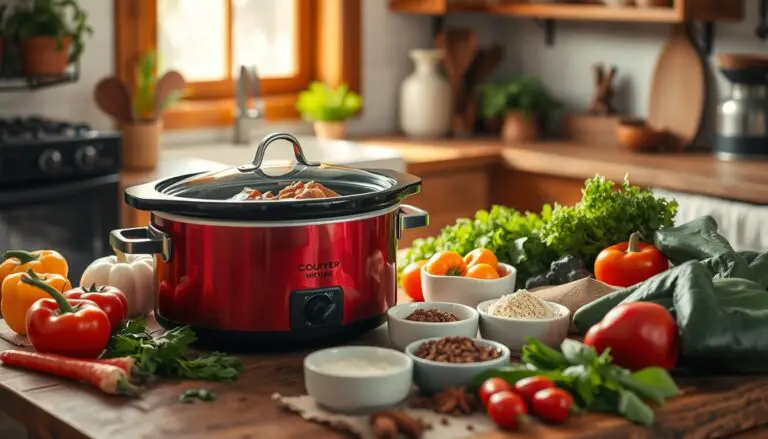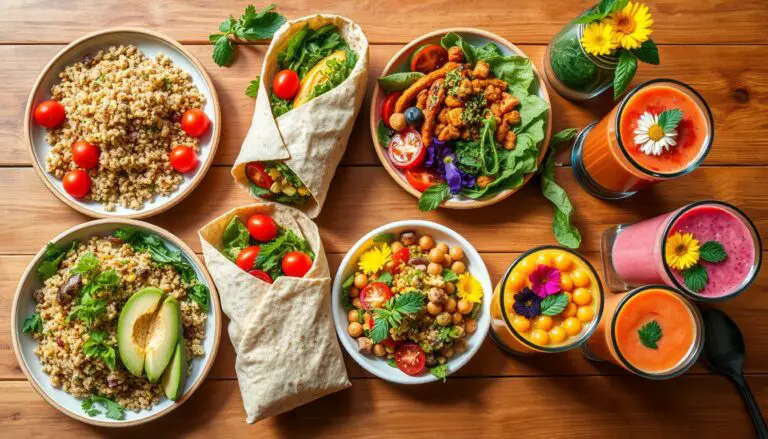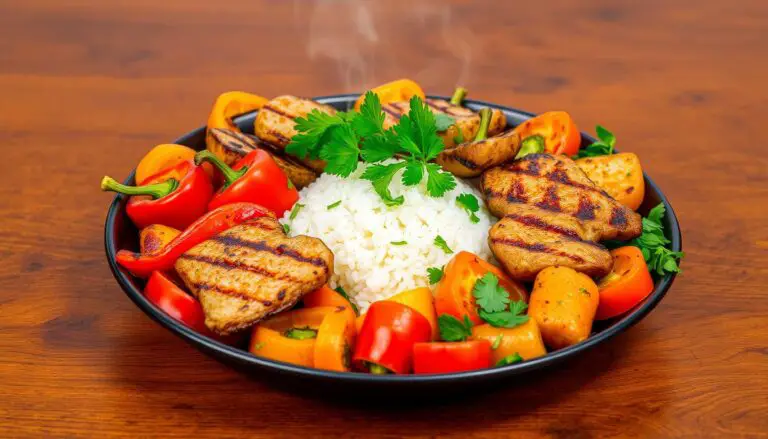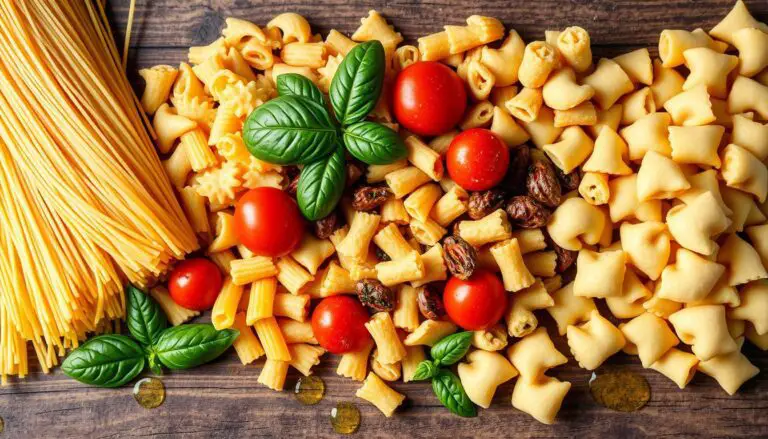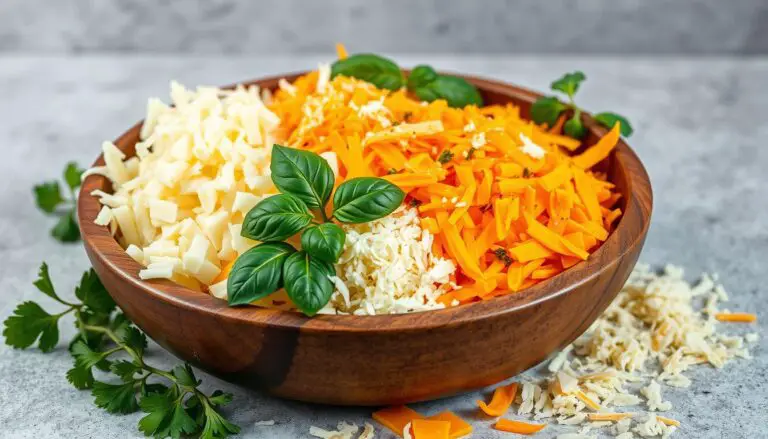Discover the 7 Types of Pasta: A Culinary Guide
Pasta is more than just a meal; it’s a celebration of flavor and culture. It’s a staple in many cuisines, inviting us to explore its many forms. In this guide, we’ll explore the 7 main types of pasta.
Each type has its own unique shape and size. This shows the rich heritage of Italian pasta and the creativity that goes beyond borders. You’ll see how pasta reflects both local traditions and global influences on our plates.
Key Takeaways
- Pasta is defined by diverse shapes and sizes, each with unique characteristics.
- There are 7 primary types of pasta explored throughout this guide.
- Italian pasta has a rich culinary heritage influencing many global cuisines.
- Pasta varieties like spaghetti, penne, and fettuccine serve different culinary purposes.
- The culture surrounding pasta is vibrant, highlighting its significance in meals worldwide.
Introduction to Pasta Varieties
Pasta has a long history that goes back to ancient times. Over the years, it has changed a lot. Now, we have many different types of pasta, each with its own shape and size.
Traditional pasta is still very popular today. It has changed a bit over time, thanks to different places and cultures. This shows how pasta can be made in many ways, using local ingredients and flavors.
Exploring pasta varieties is interesting. It shows how pasta reflects different cultures and adapts to new cooking styles. The many shapes of pasta help make meals better, by carrying flavors and textures from around the world.
What are the 7 Types of Pasta?
Pasta comes in many forms and varieties, pleasing different tastes. The seven types of pasta cover a wide range of shapes and textures. Knowing these varieties helps cooks make better choices in the kitchen.
Exploring the Characteristics of Each Type
Each of the seven pasta types has its own special qualities. These qualities make them perfect for certain dishes. Here’s a quick look at each:
- Spaghetti: Long, thin strands that are great with light sauces like marinara.
- Fettuccine: Flat ribbons that go well with creamy sauces, like Alfredo.
- Penne: Tubular, diagonally cut pasta that holds onto sauce well, often used in baked dishes.
- Lasagna: Wide sheets made for layering in oven-baked casseroles.
- Fusilli: Spiral shapes that hold onto dressings and chunky ingredients, perfect for salads.
- Macaroni: Short tubes loved in macaroni and cheese or pasta salads.
- Ravioli: Stuffed pillows filled with various ingredients, great for different fillings.
Regional Variations of Pasta Shapes
Pasta shapes vary by region, showing off local cooking traditions. Northern Italy loves richer, creamier sauces with broader pasta shapes like pappardelle. In contrast, Southern Italy prefers lighter tomato-based dishes with thinner pasta like spaghetti.
These differences show how local ingredients and customs shape pasta preparation. For a deeper dive into these pasta varieties, learning about their origins offers a glimpse into Italian cuisine.
Understanding Pasta Shapes and Their Uses
Pasta shapes are key in cooking. Each shape works best with different sauces, making meals tasty and visually appealing. For example, hollow shapes like penne and rigatoni hold sauces well because of their ridges and tubes.
Flat pasta, like fettuccine, is great for creamy sauces. Its wide surface gets covered in sauce, offering a rich taste. Knowing these differences can make your pasta dishes better.
Here’s a quick guide on matching pasta shapes with sauces:
| Pasta Shape | Best Uses | Recommended Sauces |
|---|---|---|
| Penne | Perfect for baked dishes or capturing chunky sauces | Marinara, pesto, or meat sauce |
| Fettuccine | Pairs well with creamy sauces | Alfredo or carbonara |
| Fusilli | Great for holding onto thicker sauces | Ragù or chunky vegetables |
| Farfalles | Visually appealing in salads or light sauces | Olive oil and garlic or light tomato sauce |
Trying out different pasta shapes can improve your cooking. By choosing the right pasta for your sauce, you can make your meals more exciting and delicious.
Traditional Italian Pasta: An Overview
Italian pasta has a long and rich history. It’s deeply connected to Italy’s culture. From ancient times to today, pasta has changed a lot. It started with ancient civilizations and has many different types across Italy.
History of Italian Pasta
Pasta has been in Italy for over a thousand years. It was first made from durum wheat, making it strong and useful. Old texts and digs show how pasta was made in many ways, from simple sheets to complex shapes.
This shows pasta was a big step in Italian food history. It’s not just about food; it’s about tradition and family.
Cultural Significance of Pasta in Italy
Pasta is key to Italy’s culture, more than just food. It brings families together and is at the heart of celebrations. Families share pasta recipes, showing their love and connection through food.
Regional festivals often feature pasta, using local ingredients. This shows the variety and richness of Italian cooking.
Common Pasta Forms and Their Characteristics
Pasta comes in many shapes and textures. Each is perfect for different dishes. Knowing these helps you pick the right pasta for your meal.
- Spaghetti: Long and thin, spaghetti is great with tomato-based sauces. Cooked just right, it holds sauce well.
- Linguine: A bit flatter than spaghetti, linguine is perfect for seafood and cream sauces. Its wider surface sticks to sauces better.
- Penne: Penne’s tubular shape is ideal for chunky sauces. Its ridges catch bits of food, making each bite rich.
- Farfalle: Known as bow-tie pasta, farfalle is beautiful and often used in salads or with light sauces. Its shape adds texture and style.
- Fusilli: This spiral pasta holds sauces well, making it great for thick sauces.
Every pasta type cooks differently based on its size and thickness. Pasta sizes matter when choosing sauces. Smaller pasta goes well with light sauces, while bigger pasta suits richer sauces. The right pasta can make a dish more enjoyable.
Trying out different pasta forms makes cooking fun and rewarding. It will improve your skills and make your dishes better.
Pasta Cuisine Around the World
Pasta has become a global favorite, enjoyed in many cultures. Italian pasta varieties have influenced dishes worldwide. Chefs and home cooks love using pasta in their recipes. This has led to many new pasta-based dishes with different flavors and cooking styles.
Global Influence of Italian Pasta Varieties
Italian pasta has made its mark globally. Countries like Japan, Mexico, and India have added their twist to pasta. For example, Japan loves cold noodle dishes, while Mexico puts pasta in tasty salads. This shows how pasta’s versatility and charm have won hearts worldwide.
Fusion Recipes Featuring Pasta
Fusion recipes are a fun way to mix up classic dishes. Here are some tasty examples:
- Pasta Primavera Tacos: A mix of sautéed veggies and pasta in a taco shell.
- Asian-inspired Pasta Salad: Pasta with sesame oil, cucumbers, and ginger for a cool twist.
- Curry Pasta Bake: Pasta with coconut milk, curry spices, and cheese on top.
These dishes show how pasta can be a canvas for creativity. They bring together flavors from around the world.
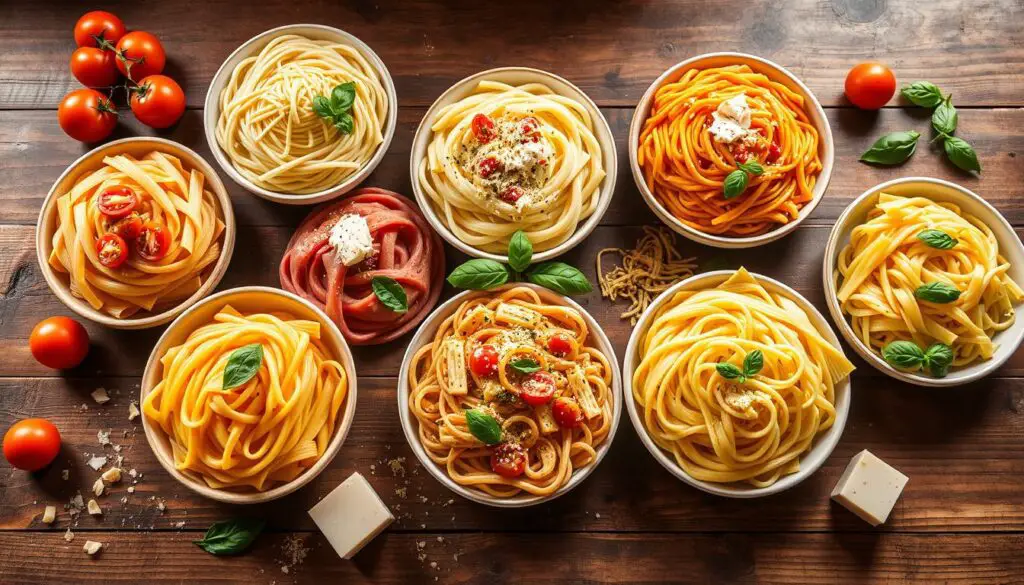
| Fusion Recipe | Main Ingredients | Flavor Profile |
|---|---|---|
| Pasta Primavera Tacos | Pasta, assorted vegetables, taco shells | Fresh, crunchy, zesty |
| Asian-inspired Pasta Salad | Pasta, sesame oil, cucumbers, ginger | Crunchy, nutty, refreshing |
| Curry Pasta Bake | Pasta, coconut milk, curry spices, cheese | Spicy, creamy, savory |
Pasta Classifications: Shapes and Sizes
Understanding pasta classifications is key in cooking. Each type of pasta has its own shape. This shape affects cooking time and the sauces it goes well with. Knowing the different shapes helps cooks pair ingredients for better flavor and texture.
Dried pasta needs longer cooking, while fresh pasta cooks fast. This difference changes how pasta holds sauces and mixes with other ingredients.
Here’s a detailed look at common pasta shapes. We’ve included cooking times and suggested sauces for each:
| Pasta Shape | Cooking Time (minutes) | Best Sauce Pairing |
|---|---|---|
| Spaghetti | 8-10 | Marinara or Bolognese |
| Penne | 11-13 | Alfredo or Arrabbiata |
| Farfalle | 10-12 | Light Cream Sauces or Pesto |
| Fusilli | 10-12 | Vegetable Sauces or Meat Sauces |
| Lasagna | 30-40 (bake time) | Rich Meats or Cheese |
In summary, pasta shapes come in many varieties. Knowing these classifications helps cooks choose the right pasta. It also helps achieve the best results in cooking.
Popular Types of Noodles in Different Cuisines
Pasta is big in Italian food, but other cultures have their own noodles. Noodles from around the world show off different cooking traditions. Learning about these noodles helps us appreciate food from everywhere.
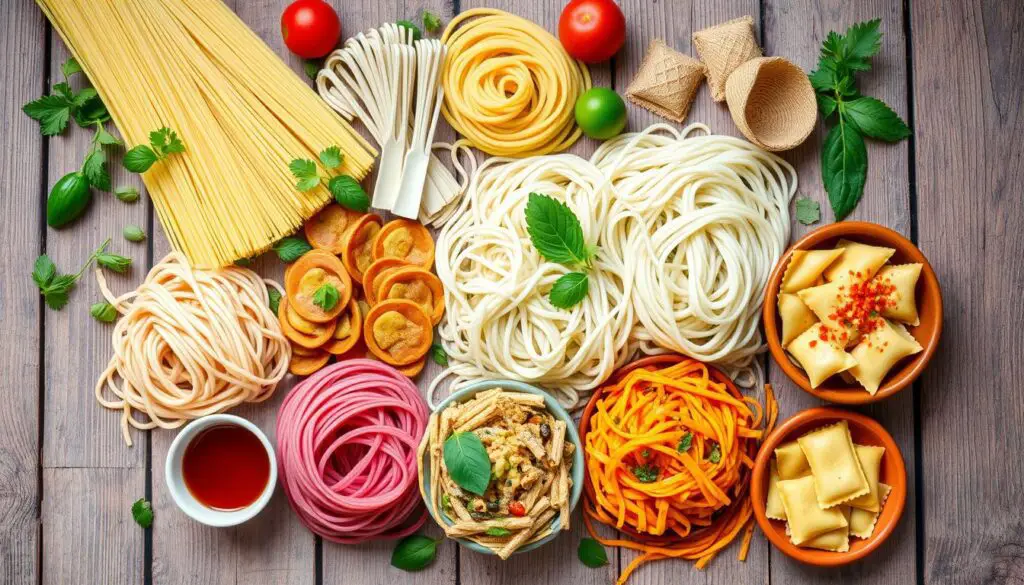
| Noodle Type | Main Ingredients | Common Dishes | Cooking Method |
|---|---|---|---|
| Udon | Wheat flour, water, salt | Udon soup, stir-fry dishes | Boiling |
| Soba | Buckwheat flour, wheat flour | Soba noodles with dipping sauce | Boiling or cold served |
| Rice Noodles | Rice flour and water | Pad Thai, Pho | Soaking or boiling |
| Egg Noodles | Wheat flour, eggs, water | Chow Mein, Chicken Noodle Soup | Boiling |
| Vermicelli | Rice flour, water | Bun Cha, Spring Rolls | Boiling |
These noodles show what different places like to eat. They’re the base for many tasty dishes that highlight local tastes. Each noodle has its own feel and flavor, inviting us to try foods from other cultures.
Cooking Techniques for Different Pasta Types
Learning to cook pasta well means knowing how to cook different types. You can boil or bake pasta, each giving a unique taste and texture. It’s important for every home cook to master these methods.
Boiling vs. Baking: Which is Best?
Boiling pasta is all about getting it just right, al dente. This keeps the pasta’s taste and lets it soak up sauces well. Using salted water boosts flavors and ensures even seasoning. On the other hand, baking pasta with sauces and cheese makes it richer, like in lasagna or baked ziti.
Pairing Sauces with Various Pasta Forms
Choosing the right sauce for your pasta can make a big difference. Light sauces like olive oil and garlic are great with thin noodles like angel hair. Thicker pasta, like fettuccine, pairs better with richer sauces like Alfredo. Knowing these pairings can make your dishes taste and look better. Check out this guide for more ideas. Here’s a table with some common pairings:
| Pasta Type | Best Sauce Pairing |
|---|---|
| Angel Hair | Light Tomato or Olive Oil |
| Bow Tie | Vegetable or Creamy Sauce |
| Fettuccine | Alfredo or Carbonara |
| Fusilli | Meat or Marinara Sauce |
Conclusion
Learning about the 7 types of pasta boosts your cooking skills and makes meals more enjoyable. Each pasta type has its own texture and taste, making dishes better. It’s key for both home cooks and chefs to try out different pasta varieties.
From simple spaghetti to hearty penne, there’s a lot to choose from. The history and cultural importance of pasta shapes add excitement to cooking. Trying new pasta and sauces is a chance to mix classic and modern recipes.
Whether you’re making a family favorite or trying something new, pasta offers endless possibilities. Exploring new cooking methods can lead to discovering a love for pasta. So, get creative and enjoy the journey of cooking with pasta.

